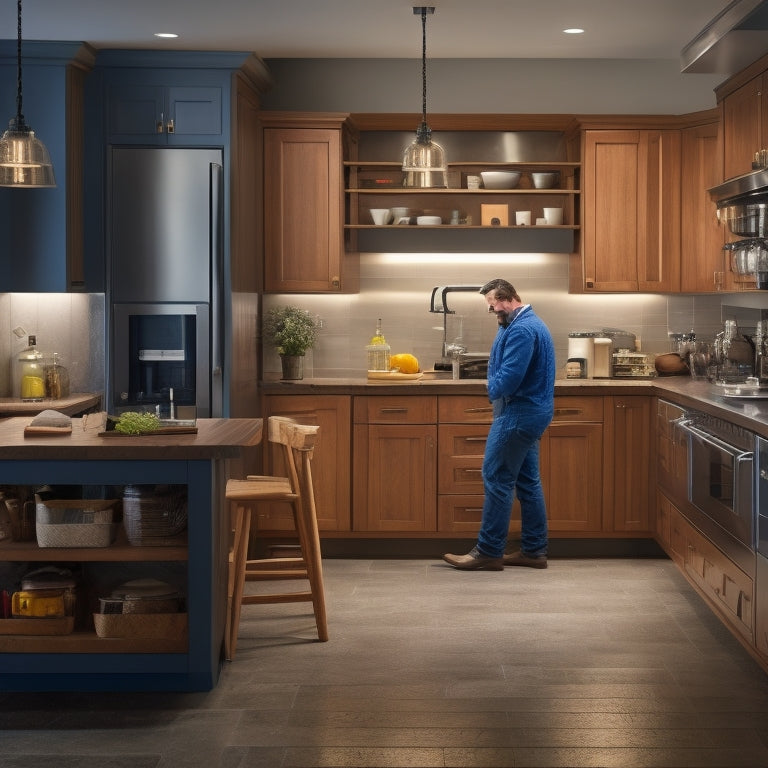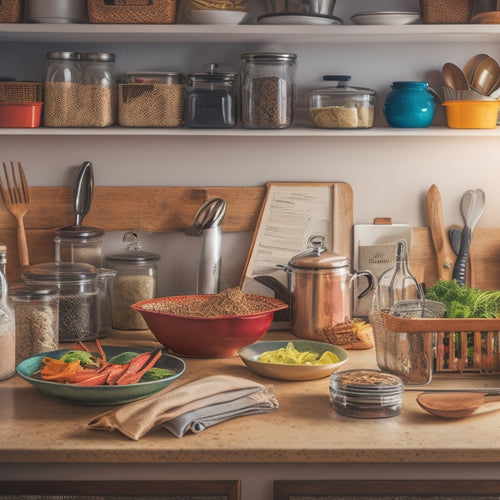
Master the Art of Cabinet Installation
Share
Mastering the art of cabinet installation demands careful attention to detail, accurate measurement, and a comprehensive understanding of installation fundamentals. Proper installation guarantees a sturdy and practical cabinet system that enhances the visual charm of any kitchen space. From effortlessly installing wall cabinets to perfecting base cabinet installation and lazy Susan installation, each stage requires accuracy, patience, and attention to detail. By understanding the intricacies of each installation type and completing it with impeccable hardware installation and crown moulding, you'll be on the right track to crafting a kitchen space that radiates elegance and sophistication, with plenty to explore throughout the process.
Key Takeaways
• Precise measurements are crucial for seamless cabinet installation, ensuring a perfect fit and avoiding costly mistakes.
• A well-planned cabinet layout is essential for proper alignment, functionality, and aesthetics, considering plumbing and electrical outlets.
• Proper installation of wall and base cabinets requires attention to detail, precision, and patience to prevent sagging and ensure durability.
• Mastering Lazy Susan installation involves meticulous attention to alignment, secure fastening, and proper mechanism attachment for smooth operation.
• Finishing touches, including crown moulding and hardware installation, elevate design and functionality, requiring precise alignment and secure installation for a polished finish.
Fundamentals of Cabinet Installation
Proper cabinet installation is an important step in guaranteeing the overall functionality and aesthetic appeal of a kitchen or bathroom, as it lays the foundation for a successful and durable cabinet system.
To achieve this, it is essential to master the fundamental steps of cabinet installation. Measuring techniques are crucial in determining the precise dimensions of the space, guaranteeing a seamless fit for the cabinets.
Having the necessary tools at hand is also crucial, as it enables efficient and accurate installation.
Installing Wall Cabinets With Ease
When preparing to install wall cabinets, it is important to carefully assess the space, taking into account factors such as the location of plumbing and electrical outlets, to guarantee a secure and level installation. A well-planned cabinet layout is vital to make sure of proper alignment and functionality.
To achieve this, measure the space accurately and create a detailed layout plan, considering the size and type of cabinets to be installed. When hanging cabinets, make sure they are level and securely fastened to the wall to prevent sagging or falling.
Proper installation of wall cabinets requires attention to detail, precision, and patience. By following these guidelines, you can achieve a professional-looking installation that enhances the overall aesthetic appeal of your kitchen or bathroom.
Mastering Base Cabinet Installation
Installing base cabinets involves understanding the unique characteristics and requirements of each type. Different designs like Base Pantry Pullout, Sink Base, Pots and Pans Pullout, and Super Cabinet require specific installation approaches for peak functionality and durability. Each base cabinet type has distinct features that must be considered during installation to ensure performance and longevity.
Proper alignment of base cabinets is crucial for their durability and functionality.
For Pantry Pullout installation, attention to door and shelf alignment is necessary for smooth operation.
Sink base techniques require careful measurement and leveling to ensure a secure and watertight seal.
The Art of Lazy Susan Installation
Lazy Susan cabinets, with their rotating shelves and doors, require meticulous attention to alignment and installation to guarantee seamless operation and prevent operational issues. Proper installation is essential to ensure smooth shelf operation and effortless door rotation.
To achieve this, aligning doors and shelves is vital. Begin by making sure the cabinet is level and securely fastened to the wall. Next, carefully attach the Lazy Susan mechanism, paying close attention to the manufacturer's instructions. Finally, adjust the shelves and doors to achieve optimal alignment, allowing for unhindered rotation and effortless access to contents.
Finishing Touches and Hardware
With the mechanical aspects of cabinet installation complete, attention turns to the aesthetic finishing touches that elevate the overall design and functionality of the cabinetry, starting with the precise installation of crown moulding and hardware. These elements not only enhance the visual appeal of the cabinets but also provide a polished, professional finish.
To achieve this, it is essential to master various hardware styles and finishing techniques.
- Selecting hardware that complements the cabinet design and style
- Executing flawless finishing techniques, such as applying a consistent stain or paint finish
- Ensuring precise alignment and secure installation of crown moulding and hardware
Frequently Asked Questions
Can I Install Cabinets Myself, or Do I Need a Professional?
When considering cabinet installation, weigh the benefits of DIY against professional expertise, factoring in budget constraints and complexity of the project, as a professional installer can guarantee best results and long-term functionality.
What Is the Recommended Cabinet Installation Temperature and Humidity?
'A million things can go wrong in cabinet installation, but ensuring perfect conditions is essential. For best results, install cabinets in a room with a consistent temperature between 60°F and 80°F (15°C and 27°C) and relative humidity below 60%, using proper tools to guarantee accuracy.'
How Do I Handle Uneven Walls or Floors During Cabinet Installation?
When encountering uneven walls or floors during cabinet installation, employ wall shimming and floor leveling techniques to guarantee proper alignment. DIY solutions may suffice for minor imperfections, but consider seeking professional help for more complex issues.
Can I Mix and Match Cabinet Brands for a Cohesive Look?
"Harmonizing diverse cabinet brands demands careful consideration of mixing styles, ensuring brand compatibility, and a keen eye for cohesive design. By doing so, you can create a visually stunning, unified look that transcends individual brand identities."
What Is the Best Way to Childproof My Newly Installed Cabinets?
To childproof your newly installed cabinets, consider safety locks and supervision as top priorities. DIY options include adhesive magnetic locks, latches, and pinch guards; however, professional solutions like custom safety devices may provide best security and peace of mind.
Related Posts
-

Baked Kale
Kale is one of the most healthiest and nutritious plant foods in existence and is delicious! Try these baked kale re...
-

7 Essential Tools to Tame Your Kitchen Chaos
You're one step away from transforming your kitchen into a haven of efficiency and calm. Start by decluttering your c...

